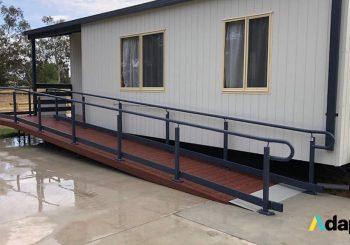Wheelchair ramps are essential for providing accessibility to individuals with mobility impairments. Due to their nature, wheelchair-accessible ramps in Australia are required to have certain safety features, such as handrails.
But, like other parts of a wheelchair ramp, handrails are also prone to regular wear and tear, especially if they’re constantly exposed to outdoor elements. That’s why it’s important to carry out regular maintenance on the handrails of your wheelchair ramp to ensure the safety of the users.
Below are helpful tips on how you can maintain the condition of your wheelchair ramp handrails.
 Regular Inspection
Regular Inspection
Regularly inspect the handrails for any signs of damage, such as rust, cracks, or loose fittings. Inspections should be conducted at least once a month or more frequently if the ramp is heavily used. It is also highly recommended to inspect the handrails after each season to see if they were affected by the changing weather conditions.
Cleaning and Debris Removal
Keep your ramp’s handrails clean by removing the accumulated debris, dust, and other obstructions. This can be done using a mild detergent and water solution. You can also use a soft brush to remove grime on the surface of the handrails.
Also, make sure to remove leaves, branches, and other large debris on the surface of the ramp to ensure the unhindered movement of the users.
Rust Prevention
To prevent rust on the handrails, apply a rust-resistant coating. This will help protect the metal from moisture and other corrosive elements. But, make sure to check the coating regularly for any signs of wear and reapply as necessary.
Tighten Loose Fittings
Sometimes, regular usage can cause the bolts, fittings, and other fasteners that are holding down the handrails to come loose. Make sure to inspect these regularly and tighten them to keep your wheelchair ramp’s handrails stable and secure. After all, loose fittings can compromise the safety of the entire ramp.
Repair Damage Promptly
If you notice any damage to the handrails during your inspections, such as cracks or bends, address and repair them promptly. Oftentimes, ignoring minor and superficial damages can cause further deterioration, which can lead to accidents and costly repairs in the future.
Ensure Proper Alignment
When inspecting your ramp’s handrails, one of the main factors you need to check is their alignment. They should always be straight and parallel to the surface and direction of your wheelchair ramp. A crooked or misaligned handrail can make it difficult for an individual with mobility issues to use your ramp.
Accessibility Compliance
In Australia, wheelchair ramps, especially those found in public places, need to comply with the latest accessibility guidelines and regulations set by the Australian Standards (AS) and the Disability Discrimination Act (DDA).
As part of your handrails’ regular maintenance, you also need to make sure that they follow the correct specifications and dimensions indicated in AS 1428.1.
If you’re looking to install handrails on your wheelchair ramp, make sure to seek the services of a professional and trusted ramps and rails builder, such as Adapta Ramps. Aside from ensuring that our handrails and modular access ramps are durable enough to withstand Australia’s harsh outdoor conditions, we also make sure that our products comply with the latest AS and DDA guidelines on accessibility.
Get in touch with us today and start designing your custom wheelchair ramp with handrails.



